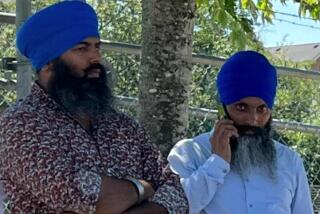Exotic, but Not Isolated
- Share via
NORTH HOLLYWOOD — At 5:30 a.m. on Sunday, two barefoot men dressed in white clothing and turbans approach the door of a bedroom inside the Sikh Gurdwara of Los Angeles, the largest Sikh temple in Southern California.
The men briefly bow, hands pressed together in a sign of respect, and then quietly walk into the small room where there is a four-poster bed, a vase of flowers on a wooden stand and a set of drawers.
Temple high priest Singh Gurdeep begins to softly chant in the Punjabi language while Karnail Singh (Singh, meaning lion, is a common Sikh name) reaches down to gently smooth the bedcovers and then peel back a thick white comforter.
Underneath is a large red book.
The early morning ritual with the book called Guru Granth Sahib, which holds the prayers at the foundation of Sikhism, goes a long way toward explaining why Sikhs can seem so exotic in a suburban outpost like North Hollywood.
Add to that the wearing of turbans by the men and scarves by women, the sword as a symbol of the religion and the fact that Sikhs do not proselytize--it adds up to a bit of cultural isolation.
But the values and beliefs of Sikhism--which is monotheistic and puts great emphasis on family, education and charity--do not seem far removed from the mainstream.
“My kids used to say to my wife, ‘You are a Jewish mother!’ ” says retired surgeon Dr. Shivdev Singh with a laugh. He and his wife were born in India, but raised their children in the San Fernando Valley.
“They would say to her, ‘You have Jewish mother syndrome.”’
The exterior of the temple also does not seem out of place--it’s a plain-looking former Masonic lodge. Even the sanctuary is basic meeting hall, although the podium area where services are conducted is elaborately painted and built to look like a traditional Indian temple, with minarets outlined in small electric bulbs.
Sitting on Floor Religious Directive
The approximately 150 Sikhs attending the 10:30 a.m. service sit cross-legged and barefoot on the carpeted floor of the immaculately clean auditorium, while service leaders sing prayers and other passages from the Guru Granth Sahib in the Punjabi language.
Sitting on the floor is not just a tradition, it’s a religious directive.
“Everyone must sit on the floor to show we are all equal,” says Sakartar Gill, who takes pledge forms during the service from attendees (the temple has no formal membership). “Even if you are king or vice president, you sit on the floor next to the common man. The only exception is for the disabled.”
At the back of the hall, a past president of the temple, who was crippled several years ago in an automobile accident, sits in his wheelchair.
Outside the room, the scene is similar to that of many churches and synagogues. Children talk and play in the outer rooms, sometimes shushed by adults. In the kitchen, men and women volunteers crowd around stoves and cutting boards to fix a community meal that will be served after the service.
Chapati breads are being hand-formed and rolled thin, rice and vegetable dishes (the meal is strictly vegetarian, although Sikhs are not expressly forbidden to eat meat) are stirred, vegetable fritters are deep-fried.
“Everyone who comes here is welcome to sit and have a meal with us, for free,” said Grusharan Nat, brother of the temple president. “They do not have to be Sikh.”
A hospitable people, yes. Gentle, no.
Gory paintings on the dining room walls depict scenes of the violent persecution of Sikhs through the centuries and their defiant stands against it.
“The guru said, at the time of persecution, that if you want democracy, you must take up the sword,” says Nat, who walks outside to the temple parking lot and gestures to the top of a flagpole where the end of a sword sits, pointing upward.
In fact, all Sikhs are supposed to carry at least ceremonial swords, but again, the outside world intervenes. “It is not practical,” says Shivdev Sing, citing “the difficulty of going on an airplane or riding a bus.”
American business has taken to the Sikhs’ strong belief in education and hard work. There is a Mercedes and several Lexuses parked in the lot, along with a few ice cream trucks.
Still, the temple, with its entrance well off a section of Lankershim Boulevard crowded with stucco apartment buildings, seems a world away from the neighborhood. Several of the men and women attending the service carry ornately sheathed daggers and in a few cases, full-length swords.
Singh Gurdeep reads from the book, which rests on white pillows on an elevated stand on the alter. When the 1,430-page volume is not being read, it’s covered in several layers of fine cloth as if to keep it safe and warm. “We consider it to be living, the living holy guru,” explains attendee Kresar Sood.
Religion Began in 15th Century
The book did not play a role in the beginnings of this relatively young religion, founded in the 15th century by Nanak Dev (1469-1539). Nine gurus came after him.
The fifth, Arjan Dev (1581-1606), started to put together the book from not only Sikh prayers, but also those of the two major religions of the time in India, Hinduism and Islam.
The tenth guru, Gobind Singh (1675-1708), added to the book and before he died proclaimed there should be no human gurus to follow. Instead, Sikhs were to sing and study the Granth Sahib.
Christians and Jews would find much of it familiar. The opening prayer declares:
“There is One God,
He is the Supreme Truth,
The all-pervading Creator . . . “
Tej Suri, who came from Punjab and is now a deputy assessor of Los Angeles County, does not feel like a stranger in this land.
“ ‘In God we trust.’ You see it on every bill in America,” he says. “Also, ‘All men are created equal.’ It is the same for us.
“We believe like Americans.”
More to Read
Sign up for Essential California
The most important California stories and recommendations in your inbox every morning.
You may occasionally receive promotional content from the Los Angeles Times.














